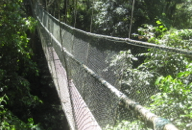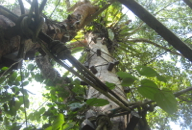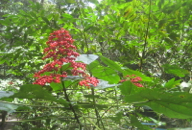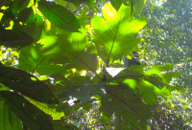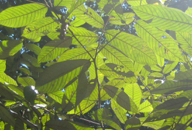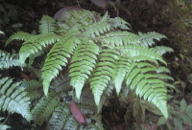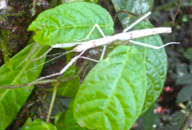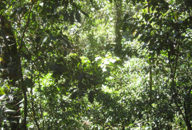RAINFOREST
GUNUNG MULU NATIONAL PARK
sarawak, east malaysia,borneo
MAY 6, 2009


RAINFOREST
GUNUNG MULU NATIONAL PARK
sarawak, east malaysia,borneo
MAY 6, 2009




Celebrating the second anniversary of our world travels, Henry and I could not have found a better place to express our love of the earth. The island of Borneo, still remote, still inhabited by indigenous tribes, and blessed with exquisite rain forests, an abundance of rivers, limestone caves, and mountains peaks, was a wonderful place to be. Gunung Mulu National Park, set on 500 square kilometers/193 square miles of rainforest, was one of the most beautiful jungle environments we have encountered. It’s swampy forest floor is accessible by river, or by foot across plank boardwalks, making walking through the forest easy and enjoyable. Our first stop on our tour of this park was the Canopy Walk, the most beautifully engineered and constructed of the three rope and cable canopies we have visited in Malaysia. Camouflaged with brown and forest green patterns to obscure it in the midst of the jungle’s beauty, the sturdy stairs to the first platform were easy to climb. Once above the forest and river below, each narrow suspension bridge was securely fastened by cables, with wood blocks protecting the bark of the trees. Henry and I and our guide, Liban, plus a park ranger, were alone as we walked over the eight netted bridges suspended between nine different trees: two Peran/Bilat trees, the Keruing tree, the Tapang tree, the Betang tree, the Pelai tree, the Meranti tree, the Seladah runching tree, and the Empitap tree. Most of the trees in the rainforest grow to a height between 25 and 35 meters/82 to 114 feet. Along the way, we learned about the swamp rainforest, looking down upon the dense, shaded foliage below us, and the leafy, interconnected canopy above our heads. We saw many epiphytes, vines and aerial plants which use the tall trees to support their growth, bringing them closer to the sunlight. Thick lianas looped around tree limbs, providing clear drinking water for the natives when cut. There are over 3,000 species of plants in this park, with all plants competing for the most important resource: sunlight. Because of the damp, swampy ground, many trees fall over before they reach their full height. These fallen tree trunks, along with vines and saplings, fill the forest floor. The trunks of the large trees collect rain water and leaves, which create a fertile habitat for many different kinds of plants, animals, and insects.
More About the Trees: (local name/family/scientific name: use)
•Peran/Bilat trees: Dipterocarpaceae/Parashorea macrophylla: provides a pale colored medium dense timber used for construction. The bark is used to make temporary walls & roofs for jungle huts. The fruit provides food for wild boar.
•Keruing tree: Dipterocarpaceae/Dipterocarpacae sp: provides a pale colored medium dense timber used for posts and beams in construction of houses. The very large leaves are used as a temporary roofing material. The fruit provides food for wild boar and porcupines.
•Tapang tree: Leguminosae/Koompasae excelsa: one of the largest emergent trees of the lowland rainforest, notable for large buttress roots which support it. The smooth bark prevents epiphytic vines from growing on the trunk. Provides a reddish timber used for crafts, for blowpipes, tool handles and fine furniture. Honey bees like to build their nests in these trees.
•Betang tree: Rubiaceae/Naucleae maingayi. Provides very dense timber for long lasting planks used to build houses and boats. Its edible fruit is a favorite of Giant Ground Squirrels and a wide variety of birds.
•Pelai tree: Apocynaceae/Alstonia pneumarophora: The tree grows up to 40 meters and provides a soft timber for woodcarving, for making a local musical instrument called the sape. The timber floats well and is used to build rafts. The latex sap is used to treat skin rashes such as small pox, boils, shingles, and centipede bites. It is also used to seal bleeding wounds on hunting dogs.
•Meranti tree: Dipterocarpaceae/Shorea sp: Provides a semi-hardwood for heavy construction and local boat making. The bark is used as s building material for roofs, floors, and walls. Its latex resin is used to caulk boats. The fruit is a favorite food of the wild boar.
•Seladah runching tree: Burseraceae/Santiria laevigata: Provides a light hardwood used for building.
•Empitap tree: Rubiaceae/Naucleae pendunculanis: The large leaves are used for wrapping food.
PHOTOS: Left Column: 1. Plants unique to Mulu: prehistoric single leaf, single stemmed plants with glossy leaves. 2. Lady Slipper orchid. 3. Leaves of the canopy. 4. False pepper plant. 5. One of the 8 suspension bridges on the canopy walk. 6. View of the tree supporting the cables for one of the suspension bridges. Blocks of wood protect the bark of the tree from being rubbed by the steel cables. Center, Top: Tiger Orchid, an amazing plant with large ((18”/nearly .5 meters long) clusters of flowers on a stalk many of which grow from the center of plant with palm-shaped leaves. This plant, I am told, flowers only once in 200 years -- so, luck was with us to see it in bloom. Center, Middle: Henry & Jourdan standing in front of a huge Tapang tree, one of the largest emergent trees in the lowland rain forest. It is so large that the width of its trunk is not visible in this photo! Center, Bottom: An assortment of ferns and epiphytes growing on an enormous Strangler Fig tree. Right Column: 1. The blossom of the Pagoda plant. 2. Leaves of the Empitap tree. Each leaf measures more than .3 meters/1 foot in length. These are used to wrap food. 3. Sun shining through the interlocking canopy of the rainforest. 4. One of the many varieties of fern growing on the swamp-like floor of the rainforest. 5. A stick insect, the color of bleached wood, a great disguise in the rainforest. 6. Dense growth of the trees and forest floor in the rainforest.


EXQUISITE RAINFOREST




